Are you dreaming of a Caribbean escape filled with lush landscapes, stunning waterfalls, and vibrant culture? SIXT.VN is here to help you turn that dream into a reality with a seamless and unforgettable travel experience to Basse-Terre, Guadeloupe. This gem of an island offers a unique blend of natural beauty and Creole charm. Let’s dive into everything you need to know to make the most of your visit, with insider tips and resources to ensure a smooth and enriching journey. Discover your perfect Caribbean getaway today.
1. What Makes Basse-Terre a Must-Visit Destination in the Caribbean?
Basse-Terre, one of the two main islands of Guadeloupe, is a must-visit destination in the Caribbean because of its unique blend of lush natural beauty and rich cultural heritage. Known for its diverse landscapes that range from rainforests and waterfalls to volcanic peaks and black sand beaches, Basse-Terre offers a range of experiences for nature lovers. Basse-Terre offers an authentic Caribbean experience that combines adventure, relaxation, and cultural immersion. According to the Guadeloupe Islands Tourist Board, Basse-Terre is increasingly popular for ecotourism, with a 15% increase in visitors seeking nature-based activities in the past year.
- Rich Natural Diversity: Basse-Terre is home to Guadeloupe National Park, a UNESCO Biosphere Reserve, featuring the iconic La Soufrière volcano, numerous waterfalls like the Carbet Falls, and diverse hiking trails.
- Authentic Creole Culture: The island’s towns and villages, such as Deshaies and Vieux-Fort, offer a glimpse into traditional Creole life with colorful markets, historic architecture, and local festivals.
- Adventure Activities: Visitors can enjoy canyoning, diving in the Cousteau Reserve, and hiking to explore the island’s natural wonders.
- Less Crowded: Compared to other Caribbean destinations, Basse-Terre offers a more peaceful and authentic experience with fewer crowds.
- Easy Access: With direct flights to Guadeloupe from major North American and European cities, Basse-Terre is easily accessible for international travelers.
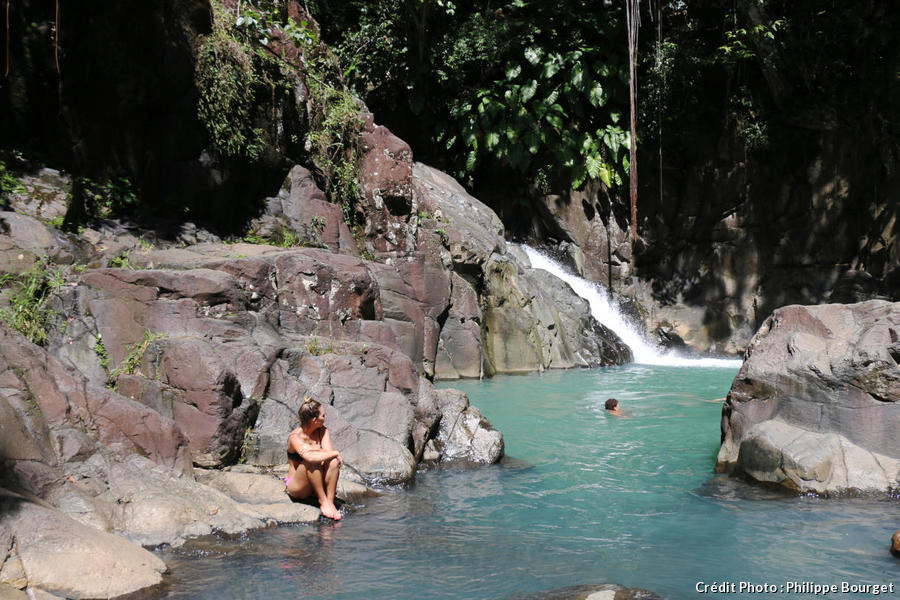 Cascade de Basse-Terre, en Guadeloupe: Basse-Terre waterfall in Guadeloupe surrounded by green forest
Cascade de Basse-Terre, en Guadeloupe: Basse-Terre waterfall in Guadeloupe surrounded by green forest
2. How Can I Explore the Stunning Waterfalls of Basse-Terre?
Exploring the waterfalls of Basse-Terre is a highlight for any visitor, offering refreshing escapes into the island’s lush interior. According to the Guadeloupe National Park, the waterfalls are best visited during the dry season (December to May) to ensure safer hiking conditions and clearer water.
- Carbet Falls: The Carbet Falls, one of the most famous attractions on Basse-Terre, consist of three distinct waterfalls. The second fall is the most accessible, requiring a moderate hike through the rainforest.
- Ecrevisses Waterfall: The Ecrevisses Waterfall is a family-friendly option, easily accessible from the main road. The short walk to the falls makes it ideal for a quick and refreshing stop.
- Acomat River: The Acomat River offers a more adventurous experience with natural slides and clear blue pools. Access involves a steep descent, making it suitable for more experienced hikers.
- Saut de la Lézarde: The Saut de la Lézarde is another beautiful waterfall accessible via a well-maintained trail. The hike is moderately challenging, offering stunning views of the surrounding forest.
- Guided Tours: Consider joining a guided tour for a more in-depth and safe exploration of the waterfalls. Local guides can provide valuable insights into the flora, fauna, and history of the area.
3. What Are the Best Canyoning Spots in Basse-Terre, Guadeloupe?
Basse-Terre offers thrilling canyoning experiences for adventure enthusiasts, with numerous mountain streams and rivers perfect for the sport. Canyoning involves navigating canyons by walking, climbing, jumping, rappelling, and swimming. According to the Association of Canyoning Professionals, it is crucial to go with certified guides to ensure safety and proper equipment use.
- Rivière Bourceau: Located in Bouillante, Rivière Bourceau is a popular spot for canyoning. It features a series of rappels, slides, and jumps, including an impressive 8-meter jump into a deep pool.
- Cascade Paradise: Cascade Paradise offers a gentler introduction to canyoning, suitable for families and beginners. It includes smaller slides and jumps in a picturesque setting.
- Trou à Diable: For more experienced canyoners, Trou à Diable offers a challenging route with technical rappels and stunning scenery.
- Safety First: Always wear a helmet, harness, and appropriate footwear. Listen carefully to your guide’s instructions and follow safety protocols.
- Book in Advance: Canyoning tours are popular, so it’s advisable to book in advance, especially during peak tourist season.
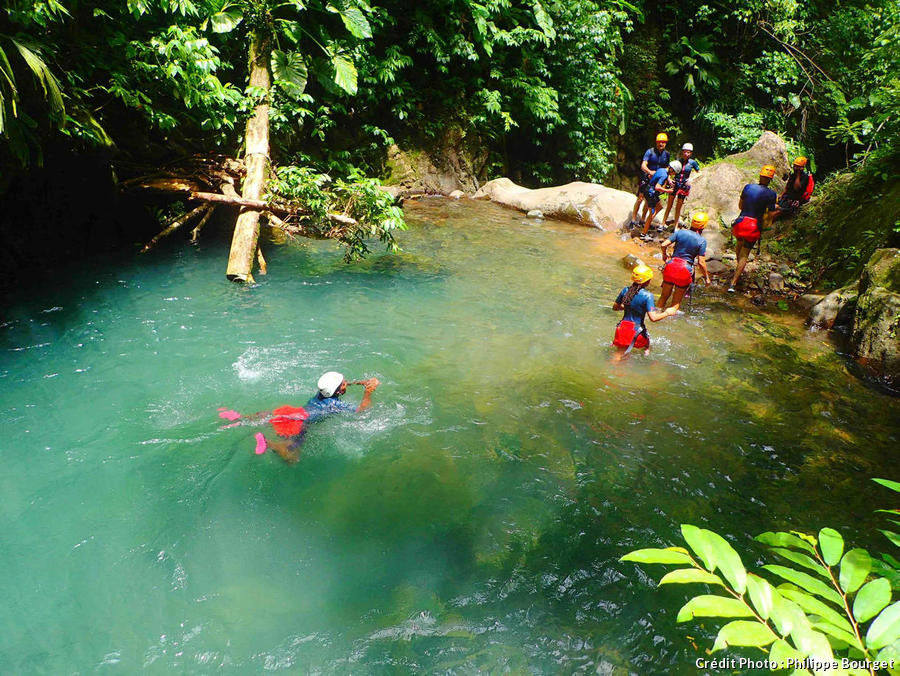 Canyoning sur les rivières de Basse-Terre, en Guadeloupe: People canyoning in Basse-Terre river, Guadeloupe
Canyoning sur les rivières de Basse-Terre, en Guadeloupe: People canyoning in Basse-Terre river, Guadeloupe
4. How Can I Hike to the Summit of La Soufrière Volcano?
Hiking to the summit of La Soufrière, the highest peak in the Lesser Antilles, is a must-do for avid hikers visiting Basse-Terre. According to the Guadeloupe National Park, the hike is considered difficult due to the tropical climate and steep terrain, requiring good physical fitness and appropriate gear.
- Starting Point: Begin your hike at the Bains Jaunes parking area, the closest accessible point to the volcano’s base. The road to La Savane à Mulets is currently closed due to seismic activity.
- Trail Conditions: The trail is well-marked with yellow blazes and information panels provided by the Guadeloupe National Park. The first section is paved, transitioning to a rocky path as you ascend.
- Duration and Difficulty: The round trip takes approximately 4.5 to 5 hours, with a positive elevation gain of 513 meters. The hike is rated as difficult, especially in the humid tropical environment.
- Safety Precautions: Stay on marked trails and heed any safety warnings from park authorities.
- Best Time to Hike: The best time to hike La Soufrière is early in the morning on a clear day to maximize your chances of enjoying panoramic views from the summit.
5. What Should I Know About Diving in the Jacques Cousteau Underwater Reserve?
Diving in the Jacques Cousteau Underwater Reserve, located off the coast of Basse-Terre, is a world-renowned experience, celebrated for its vibrant marine life and accessible dive sites. According to the reserve’s official website, the area is a protected natural marine reserve, integrated into the Guadeloupe National Park, and spans 1,000 hectares of underwater terrain.
- Marine Biodiversity: The reserve is home to a diverse array of marine species, including colorful fish, coral reefs, and sea turtles, making it an ideal spot for both novice and experienced divers.
- Popular Dive Sites: Key dive sites include the Îlet Pigeon, offering shallow dives perfect for beginners, and the Cousteau bust, a submerged statue commemorating the famous oceanographer.
- Diving Clubs: Numerous diving clubs operate from Malendure Beach, offering baptism dives, guided tours, and certification courses. Les Heures Saines is one of the oldest and most reputable.
- Snorkeling: For those who prefer to stay closer to the surface, snorkeling is also a popular activity, with clear waters and abundant marine life easily visible from the surface.
- Conservation Efforts: The reserve is actively managed to protect its marine ecosystem, with regulations in place to minimize environmental impact.
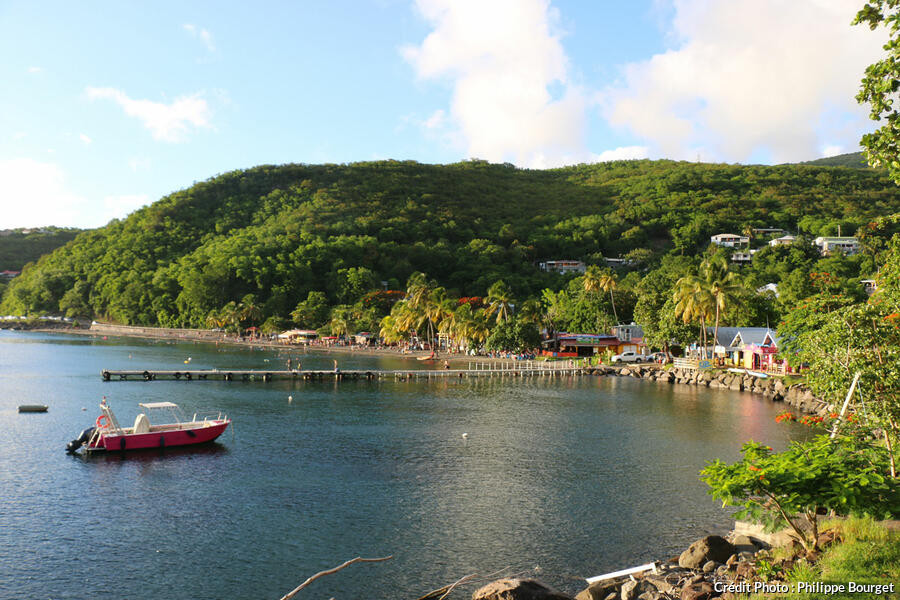 La plage de Malendure, à Bouillante, en Guadeloupe: Malendure beach in Bouillante, Guadeloupe with dark sand and palm trees
La plage de Malendure, à Bouillante, en Guadeloupe: Malendure beach in Bouillante, Guadeloupe with dark sand and palm trees
6. Which Creole Villages in Basse-Terre Should I Visit?
Visiting the Creole villages of Basse-Terre offers a glimpse into the island’s rich cultural heritage and traditional way of life. The villages along Basse-Terre’s coasts and inland areas retain a unique charm and historical significance.
- Sainte-Rose: Located in the northeast, Sainte-Rose is a maritime and agricultural village known for its access to the Grand-Cul-de-Sac Marin, a vast lagoon with mangrove forests. Boat tours offer environmental explorations.
- Deshaies: On the northwest coast, Deshaies features colorful houses along the Caribbean Sea. It is a fishing port and agricultural center where vanilla, coffee, and cocoa are grown. The village is particularly beautiful at sunset.
- Vieux-Fort: At the southern tip of Basse-Terre, Vieux-Fort offers stunning views of the Îles des Saintes archipelago. The village features a historic church and a lighthouse, and is a popular spot for windsurfing and kitesurfing.
- Saint-Claude: Situated beneath the Soufrière volcano, Saint-Claude is a cooler, elevated village with beautiful Creole houses and historic buildings.
- Capesterre Belle Eau: On the southeast coast, Capesterre Belle Eau is where Christopher Columbus first landed in Guadeloupe. The village is known for its banana plantations, the Allée Dumanoir, and the Changy Hindu temple.
7. What Are the Key Attractions in Capesterre Belle Eau?
Capesterre Belle Eau, located on the southeast coast of Basse-Terre, is a village rich in history, culture, and natural beauty, offering several key attractions for visitors. According to historical records, Christopher Columbus landed here in November 1493, marking a significant moment in the island’s history.
- Allée Dumanoir: This iconic avenue, lined with royal palms planted in the mid-19th century, is a must-see. The straight, palm-lined road offers a picturesque setting for a leisurely drive or stroll.
- Changy Hindu Temple: This temple is a testament to the presence of the Indian community on the island, who arrived in the 19th century to replace enslaved laborers. The temple is a colorful and culturally significant site.
- Banana Plantations: Capesterre Belle Eau is an agricultural heartland, known for its banana cultivation. Visitors can tour local plantations to learn about the cultivation process and sample fresh bananas.
- Sainte-Marie Landing Site: The historical site where Christopher Columbus landed is commemorated with a marker, providing a glimpse into the island’s colonial past.
- Proximity to Carbet Falls: Capesterre Belle Eau serves as a gateway to the Carbet Falls, one of the most spectacular natural attractions on Basse-Terre.
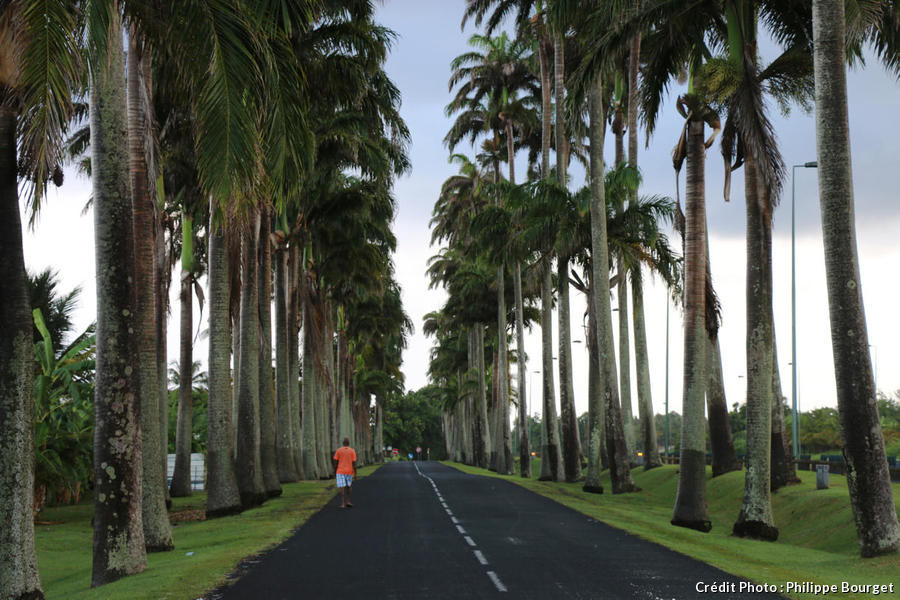 Le village de Capesterre Belle Eau, à Basse-Terre, en Guadeloupe: Dumanoir alley in Capesterre Belle Eau village, Basse-Terre, Guadeloupe
Le village de Capesterre Belle Eau, à Basse-Terre, en Guadeloupe: Dumanoir alley in Capesterre Belle Eau village, Basse-Terre, Guadeloupe
8. Why Is the Route de la Traversée a Must-Drive Road in Basse-Terre?
The Route de la Traversée, or D23, is a must-drive road in Basse-Terre because it offers a scenic journey through the heart of Guadeloupe’s lush rainforest, providing access to numerous natural attractions. Stretching nearly 25 km, this road cuts through Basse-Terre from east to west, showcasing the island’s rich ecosystem.
- Lush Landscapes: The road winds through dense tropical forests, offering breathtaking views of the surrounding greenery.
- Major Attractions: The Route de la Traversée provides easy access to key sites such as the Cascade aux Ecrevisses, the Saut de la Lézarde, the Maison de la Forêt, and the Parc des Mamelles.
- Cool Climate: The elevated route offers a welcome escape from the humid coastal climate, with cooler temperatures and refreshing breezes.
- Wildlife Viewing: The road passes through areas rich in wildlife, offering opportunities to spot native birds, reptiles, and mammals.
- Historical Significance: Inaugurated in 1967, the Route de la Traversée played a crucial role in connecting the eastern and western coasts of Basse-Terre.
9. What Can I Expect to See at the Parc des Mamelles?
The Parc des Mamelles, also known as the Guadeloupe Zoo, is a unique zoological park located on the Route de la Traversée in Basse-Terre. It is named after the two prominent hills, Mamelle du Pigeon and Mamelle de Petit-Bourg.
- Diverse Wildlife: The park is home to a wide variety of animals native to the Caribbean and other tropical regions, including birds, reptiles, and mammals.
- Natural Enclosures: Animals are housed in enclosures designed to mimic their natural habitats, providing visitors with an immersive viewing experience.
- Suspended Walkways: A highlight of the park is the series of suspended walkways that allow visitors to observe animals from above, offering a unique perspective on the rainforest ecosystem.
- Educational Programs: The Parc des Mamelles offers educational programs and exhibits that highlight the importance of conservation and biodiversity.
- Family-Friendly: The park is an ideal destination for families with young children, offering a fun and educational experience in a natural setting.
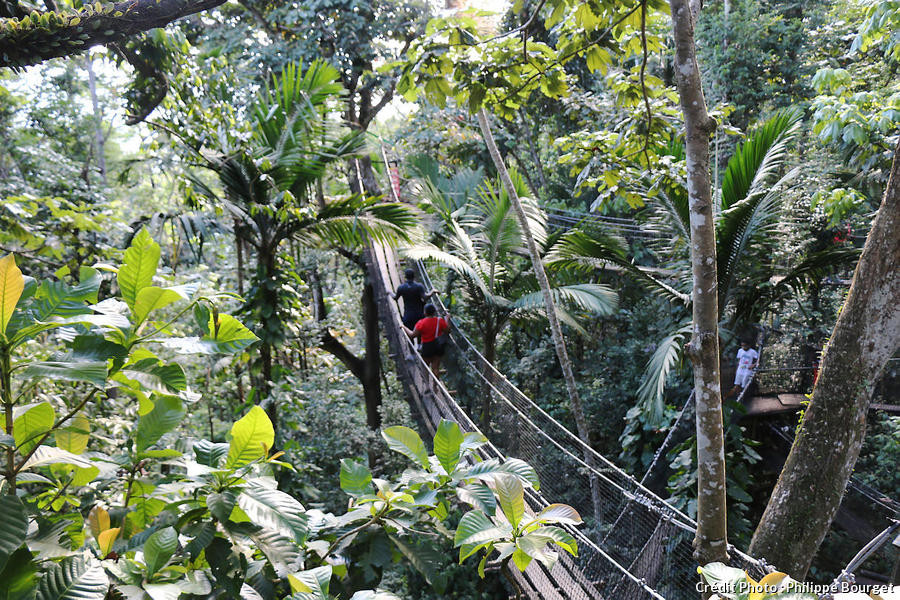 Le parc des Mamelles, à Basse-Terre, en Guadeloupe: The Mamelles Park in Basse-Terre, Guadeloupe with lush green forest
Le parc des Mamelles, à Basse-Terre, en Guadeloupe: The Mamelles Park in Basse-Terre, Guadeloupe with lush green forest
10. Why Should I Visit the Deshaies Botanical Garden?
Visiting the Deshaies Botanical Garden, located above the village of Deshaies in Basse-Terre, is a must for nature lovers and those seeking a tranquil escape. This garden is a beautifully designed collection of tropical plants, offering a fascinating lesson in tropical botany.
- Tropical Flora: The garden showcases a wide variety of trees, shrubs, and flowers, representing the diverse plant life of the Caribbean and other tropical regions.
- Lorikeet Aviary: One of the garden’s highlights is the lorikeet aviary, home to colorful parrots from Australia. Visitors can feed the birds with sugar juice, creating a delightful experience, especially for children.
- Scenic Views: The garden offers stunning views of the surrounding landscape, including the village of Deshaies and the Caribbean Sea.
- Historical Significance: The garden is located on the former estate of French comedian Coluche, adding a touch of history and celebrity to the site.
- Family-Friendly: The Deshaies Botanical Garden is an ideal destination for families, offering a mix of natural beauty, educational exhibits, and interactive experiences.
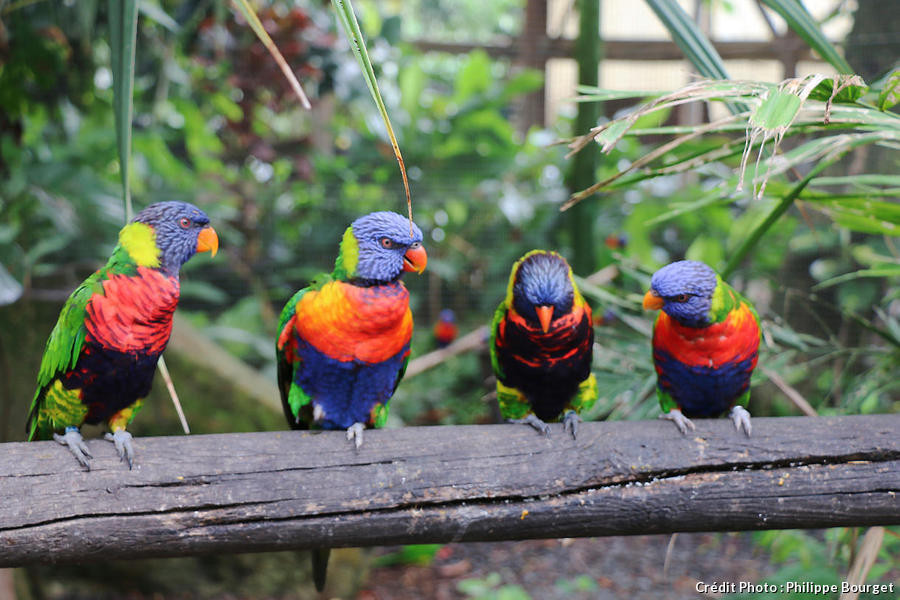 Le jardin botanique de Deshaies, à Basse-Terre, en Guadeloupe: Botanical garden of Deshaies, Basse-Terre, Guadeloupe with colourful flowers
Le jardin botanique de Deshaies, à Basse-Terre, en Guadeloupe: Botanical garden of Deshaies, Basse-Terre, Guadeloupe with colourful flowers
11. What Are the Best Beaches in Basse-Terre?
Basse-Terre boasts a diverse range of beaches, each offering a unique experience, from black sand shores to secluded coves. According to TripAdvisor, Grande Anse in Deshaies is consistently ranked as one of the best beaches in Guadeloupe.
- Grande Anse (Deshaies): This iconic beach is known for its golden sand, clear waters, and lush vegetation. It’s perfect for swimming, sunbathing, and enjoying the sunset.
- Plage de Malendure (Bouillante): Famous for its black sand and proximity to the Jacques Cousteau Underwater Reserve, this beach is a hub for diving and snorkeling activities.
- Plage de la Caravelle (Sainte-Anne): Located near Sainte-Anne, this beach offers calm waters and a family-friendly atmosphere.
- Plage de Bananier (Capesterre Belle Eau): This secluded beach is known for its tranquility and natural beauty, offering a peaceful escape from the crowds.
- Anse de la Perle (Deshaies): Another beautiful beach in Deshaies, Anse de la Perle, offers a relaxed atmosphere and stunning views.
12. Where Can I Find the Best Local Cuisine in Basse-Terre?
Finding the best local cuisine in Basse-Terre involves exploring the island’s markets, roadside eateries, and restaurants, each offering a taste of authentic Creole flavors. According to culinary experts, dishes like “colombo,” “bokit,” and fresh seafood are must-tries when visiting Guadeloupe.
- Local Markets: Visit local markets in towns like Pointe-à-Pitre and Basse-Terre to sample fresh produce, spices, and prepared foods.
- Roadside Eateries: Look for small, family-run eateries along the roadsides, offering traditional dishes at affordable prices.
- Seafood Restaurants: Head to coastal villages like Deshaies and Bouillante for restaurants specializing in fresh seafood, prepared with Creole spices and flavors.
- Creole Restaurants: Explore Creole restaurants in towns like Saint-Claude and Capesterre Belle Eau, offering a range of local specialties, including “colombo,” a flavorful curry dish.
- Food Festivals: Check for local food festivals and events that showcase the best of Guadeloupean cuisine.
13. What Are Some Family-Friendly Activities in Basse-Terre?
Basse-Terre offers a variety of family-friendly activities, ensuring that visitors of all ages can enjoy their time on the island. According to family travel blogs, activities like visiting the Parc des Mamelles, exploring the Deshaies Botanical Garden, and swimming at the Ecrevisses Waterfall are popular choices.
- Parc des Mamelles: This zoological park is a hit with children, offering the chance to see native animals in natural enclosures and walk along suspended walkways.
- Deshaies Botanical Garden: The garden offers a beautiful setting for a family stroll, with colorful plants, exotic birds, and interactive exhibits.
- Ecrevisses Waterfall: This easily accessible waterfall is perfect for a refreshing swim, with shallow pools and a short walking trail suitable for young children.
- Beaches: Spend a day at one of Basse-Terre’s beaches, such as Grande Anse or Plage de la Caravelle, for swimming, sunbathing, and building sandcastles.
- Canyoning for Families: Some canyoning tours are designed for families, offering gentler routes with smaller slides and jumps.
14. What Types of Accommodation Are Available in Basse-Terre?
Basse-Terre offers a range of accommodation options to suit different preferences and budgets, from hotels and guesthouses to bungalows and villas. According to Booking.com, the southern region of Basse-Terre is ideal for those seeking hiking opportunities and natural activities.
- Hotels: Hotels in Basse-Terre range from boutique establishments to larger resorts, offering amenities such as swimming pools, restaurants, and spa services.
- Guesthouses: Guesthouses provide a more intimate and personalized experience, often run by local families.
- Bungalows: Bungalows are a popular choice for those seeking a closer connection to nature, often located in lush settings with views of the rainforest or coastline.
- Villas: Villas offer spacious and private accommodations, ideal for families or groups. They often come with amenities such as private pools and fully equipped kitchens.
- Eco-Lodges: For environmentally conscious travelers, eco-lodges offer sustainable accommodations with a focus on minimizing environmental impact.
15. What Events and Festivals Should I Know About When Visiting Basse-Terre?
Visiting Basse-Terre during one of its many events and festivals offers a unique opportunity to experience the island’s vibrant culture and traditions. According to the Guadeloupe Islands Tourist Board, the Carnival season and the Fête de la Musique are among the most popular events.
- Carnival: Held in the months leading up to Lent, Carnival is a colorful and lively celebration featuring parades, music, dance, and elaborate costumes.
- Fête de la Musique: Celebrated on June 21, this music festival features free performances by local and international artists throughout the island.
- Sainte-Rose Festival: This annual festival in Sainte-Rose celebrates the village’s patron saint with religious ceremonies, music, dance, and cultural events.
- Deshaies Festival: Held in Deshaies, this festival showcases the village’s maritime traditions with boat races, fishing competitions, and seafood feasts.
- Agricultural Fairs: Throughout the year, agricultural fairs are held in various villages, showcasing local produce, crafts, and culinary specialties.
16. What Are the Best Shopping Opportunities in Basse-Terre?
Basse-Terre offers a range of shopping opportunities, from local markets selling fresh produce and spices to boutiques offering handcrafted souvenirs. According to travel guides, the best shopping experiences can be found in the towns of Pointe-à-Pitre and Basse-Terre.
- Local Markets: Visit local markets to purchase fresh fruits, vegetables, spices, and local handicrafts.
- Art Galleries: Explore art galleries in towns like Deshaies and Saint-François to discover works by local artists.
- Craft Shops: Look for craft shops selling handmade souvenirs, such as pottery, jewelry, and textiles.
- Rum Distilleries: Visit local rum distilleries to purchase bottles of authentic Guadeloupean rum.
- Fashion Boutiques: Explore fashion boutiques in towns like Pointe-à-Pitre to find clothing and accessories by local designers.
17. How Can I Get Around Basse-Terre?
Getting around Basse-Terre can be achieved through various transportation options, each offering different levels of convenience and flexibility. According to local transportation guides, renting a car is the most convenient way to explore the island’s diverse landscapes.
- Rental Cars: Renting a car provides the most freedom to explore Basse-Terre at your own pace. Several rental agencies operate at the airport and in major towns.
- Taxis: Taxis are available in major towns and tourist areas, but they can be expensive for longer journeys.
- Buses: Public buses provide an affordable way to travel between towns, but they can be infrequent and unreliable.
- Organized Tours: Joining organized tours can be a convenient way to visit popular attractions without having to worry about transportation.
- Ferries: Ferries connect Basse-Terre to other islands in the Guadeloupe archipelago, such as Les Saintes and Marie-Galante.
18. What Should I Pack for a Trip to Basse-Terre?
Packing for a trip to Basse-Terre requires considering the island’s tropical climate, diverse activities, and cultural norms. According to travel checklists, essential items include lightweight clothing, swimwear, and sunscreen.
- Lightweight Clothing: Pack lightweight, breathable clothing made from cotton or linen to stay cool in the tropical heat.
- Swimwear: Bring swimwear for swimming at the beaches and waterfalls.
- Sunscreen: Protect your skin from the sun with high-SPF sunscreen.
- Insect Repellent: Mosquitoes and other insects can be prevalent, especially in the rainforest, so bring insect repellent.
- Hiking Shoes: If you plan to hike, bring sturdy hiking shoes with good traction.
- Rain Gear: Pack a lightweight rain jacket or umbrella, as rain showers can occur at any time of year.
- Hat and Sunglasses: Protect yourself from the sun with a wide-brimmed hat and sunglasses.
- Reusable Water Bottle: Stay hydrated by bringing a reusable water bottle.
19. What Are Some Essential French Phrases to Know When Visiting Basse-Terre?
Knowing some essential French phrases can enhance your experience when visiting Basse-Terre, as French is the official language of Guadeloupe. According to language learning guides, basic greetings and polite expressions can go a long way in making a positive impression.
- Bonjour: Hello / Good morning
- Bonsoir: Good evening / Good night
- Merci: Thank you
- S’il vous plaît: Please
- Excusez-moi: Excuse me
- Parlez-vous anglais?: Do you speak English?
- Je ne comprends pas: I don’t understand
- Comment allez-vous?: How are you?
- Bien, merci: Fine, thank you
- Au revoir: Goodbye
20. How Can SIXT.VN Enhance My Trip to Basse-Terre?
SIXT.VN can significantly enhance your trip to Basse-Terre by providing a range of convenient and reliable travel services, tailored to meet your specific needs.
- Airport Transfers: SIXT.VN offers seamless airport transfer services, ensuring a stress-free arrival and departure.
- Hotel Booking: SIXT.VN can assist with booking accommodations, offering a variety of options to suit different budgets and preferences.
- Tour Packages: SIXT.VN provides curated tour packages, allowing you to explore the best of Basse-Terre with expert guides and comfortable transportation.
- Car Rentals: SIXT.VN offers car rental services, providing you with the freedom to explore the island at your own pace.
- Customer Support: SIXT.VN provides dedicated customer support to assist you with any questions or concerns, ensuring a smooth and enjoyable travel experience.
Address: 260 Cau Giay, Hanoi, Vietnam
Hotline/Whatsapp: +84 986 244 358
Website: SIXT.VN
FAQ Section
-
Why is the capital of Guadeloupe called Basse-Terre?
The capital of Guadeloupe, Basse-Terre, gets its name from its geographical location and the nautical term for land that is sheltered from the wind. -
Where is the best place to stay in Basse-Terre?
The south of Basse-Terre is ideal for hiking and nature activities due to its proximity to Guadeloupe National Park and the Soufrière volcano. The coastline is more suitable for combining relaxation on volcanic beaches with exploring Creole villages. -
What type of accommodation should I choose for my stay in Basse-Terre?
Basse-Terre offers numerous accommodation options that often provide beautiful stays in a natural setting. Bungalows are recommended for those wanting to connect with nature, while hotels or guesthouses are better for visitors who prefer comfort, with options ranging from basic to fully equipped. -
What is Basse-Terre known for?
Basse-Terre is known for its natural beauty, including the Soufrière volcano, Carbet Falls, and Jacques Cousteau Underwater Reserve. It’s also recognized for its rich Creole culture and historical significance. -
When is the best time to visit Basse-Terre for good weather?
The best time to visit Basse-Terre for good weather is during the dry season, which runs from December to May. This period offers lower rainfall and more sunshine, making it ideal for outdoor activities. -
Are there any entry requirements for visiting Basse-Terre?
As part of France, Basse-Terre follows the entry requirements of the European Union. Citizens of many countries, including the United States, Canada, and Australia, can enter without a visa for stays of up to 90 days. -
Is Basse-Terre safe for tourists?
Basse-Terre is generally safe for tourists. However, it’s always wise to take standard safety precautions, such as being aware of your surroundings, securing your valuables, and avoiding isolated areas at night. -
Can I use US dollars in Basse-Terre?
The official currency in Basse-Terre is the Euro (EUR). While some establishments may accept US dollars, it’s recommended to exchange your currency for Euros to ensure smooth transactions. -
What are some popular dishes I should try in Basse-Terre?
Some popular dishes to try in Basse-Terre include “colombo” (a flavorful curry), “bokit” (a type of fried sandwich), fresh seafood, and local fruits like mangoes and passion fruit. -
Are there any cultural etiquette tips I should be aware of when visiting Basse-Terre?
When visiting Basse-Terre, it’s polite to greet people with “Bonjour” or “Bonsoir” depending on the time of day. Dress modestly when visiting religious sites and be respectful of local customs and traditions.
With SIXT.VN, planning your trip to Basse-Terre is easier than ever. From airport transfers to hotel bookings and curated tour packages, SIXT.VN provides everything you need for a seamless and unforgettable travel experience. Explore the natural beauty, immerse yourself in the vibrant culture, and create lasting memories on this Caribbean gem. Contact SIXT.VN today to start planning your dream getaway.



